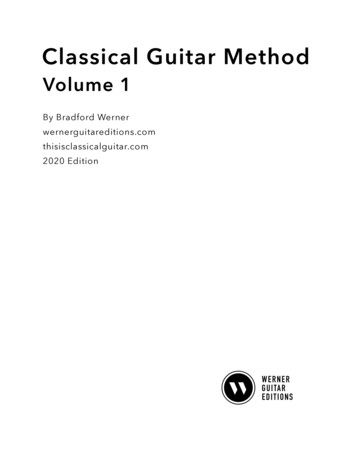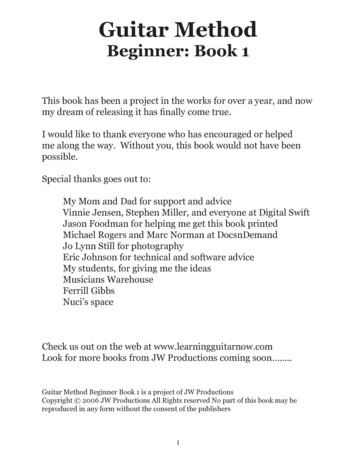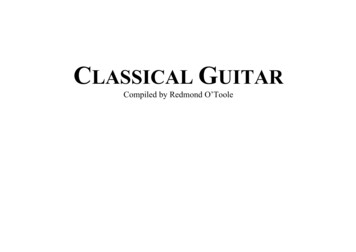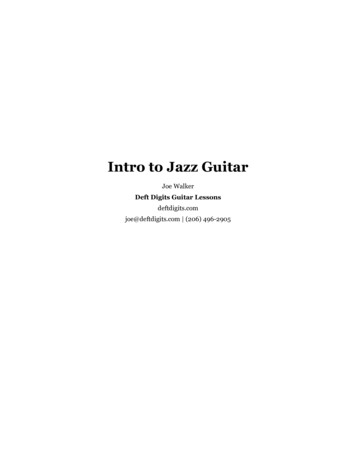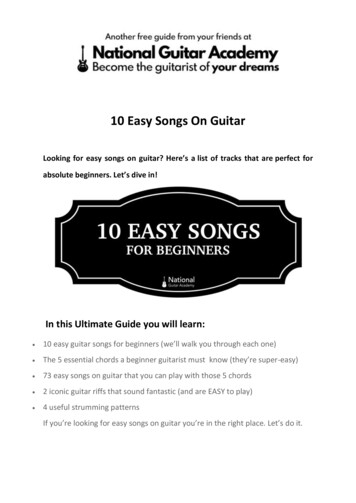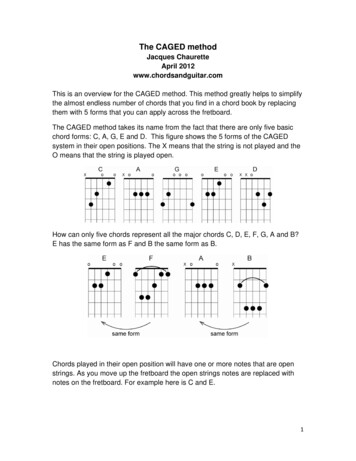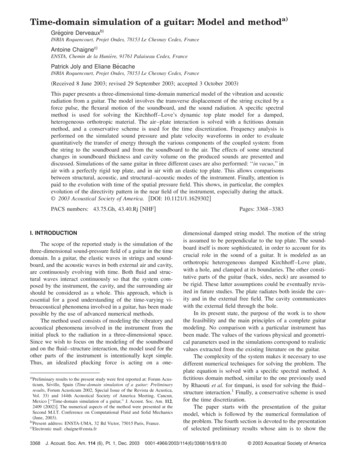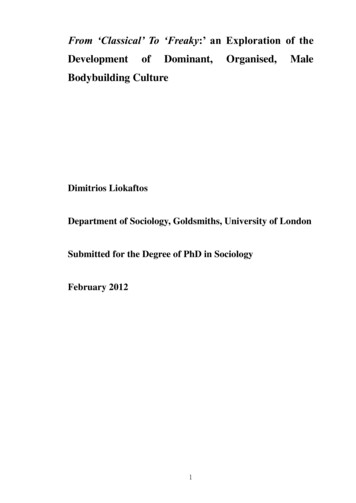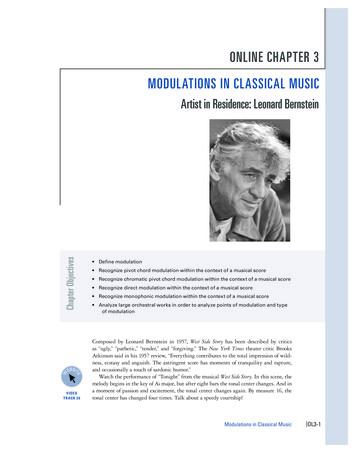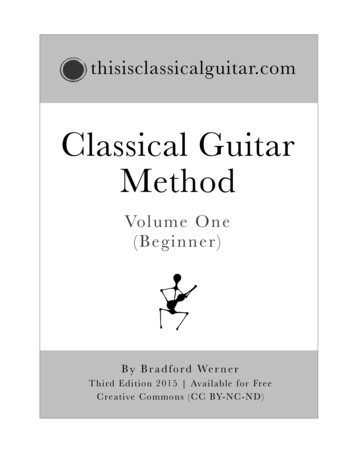
Transcription
thisisclassicalguitar.comClassical GuitarMethodVolume One(Begin n er)B y B r a d f o r d We r n e rT h ird Edition 2015 Available for FreeCreative Common s (CC BY-NC-ND)
Classical Guitar Method!Volume I (Beginner) !By Bradford Werner!thisisclassicalguitar.com !!Third Edition 2014 !Available for Free Download!!!!!!!!This work is licensed under the Creative Commons Attribution-NonCommercial-NoDerivatives 4.0International License. To view a copy of this license, d/4.0/!!You can share this work but must give proper credit, link to my site and mention the license. You may notsell this work, use it for commercial purposes, or alter it and/or distribute a modified version. It’s simple,if you share this work you must include the below info (make sure the url is an active link):!!!!!!!!!!Classical Guitar Method - Volume One (2014) by Bradford Werner is licensed under a CreativeCommons Attribution-NonCommercial-NoDerivatives 4.0 International License.!Original Source: http://thisisclassicalguitar.com!Special thanks to my friends, family, and colleagues who have used my books and contributed helpfulfeedback: Erin Fisher, Jeff Werner Michael Dias, Adrian Verdejo, and Douglas Hensley. !!Bradford C. Werner 2014 !www.bradfordwerner.ca!!Sheet Music, Lessons, Daily Blogging: !www.thisisclassicalguitar.com!!Made in Victoria, British Columbia, Canada!"ii
TABLE OF CONTENTS!!PART I: PROGRESSIVE METHOD!7!Introduction to Notation and Rhythm!10!Right Hand Walking No. 1 & 2, Arpeggio Prelude!13!Open String Duets: Nocturne, Nuevo Tango!15!Left Hand Notes, Prelude No. 1, Prelude No. 2, Notes, Ode to Joy!21!Notes and C Major Scale, Note Naming No. 1, Twinkle Twinkle, Jazz Cat No. 1!25!Eighth Notes, Allegro, New Notes, Note Naming No. 2, Summer Cicada, Sor Study, !31!Accidentals & Chromatic Scale, Greensleeves, Minuet in G, Note Naming No. 3!35!Checkpoint No. 1 !36!New notes, Canon in D, Short Reading Works, Impertinence Duet!40!In the Hall of the Mountain King, Jesu Joy Of Man’s Desiring, Canary Jig, Turkey in the Straw!42!Major Scale Theory !43!Checkpoint No. 2!45!Two-Voice Textures: The Swan, Leyenda, Sicilano,!48!Arpeggio Prelude No. 2, Django Swing, Tutu Maramba, Very Little Romance!52!Final Pieces: Andante, Spagnoletta!!PART II: CHORDS & BLUES!54!First Chords, London Bridge, Expanding Chords, Tom Dooley, Full Chords, Red River Valley!57!Scarborough Fair, Saint James Infirmary, House of the Rising Sun!60!Chord construction and reference chord progressions: I, IV, V, vi Chords !64!I, IV, V Practice; I, IV, V,vi Practice!66 !Scales for Blues and Popular music: Pentatonic Minor and Blues Scales !67!Twelve Bar Blues, The Shuffle, Rhythm Riff Blues!!PART III: SUPPLEMENT!70!Harmonic/melodic intervals, Introduction to 3rd and 5th Position !72!Right-hand alternation on open strings, left-hand placement and slurs!74!Scales: Single String Scales, Chromatic on E, Major and Natural Minor!79!Blank Notation Paper!!!!"iii
!ABOUT THIS BOOK!Video Lessons!Video lessons for this book have been made to help students successfully complete the material. !Look for the list heading Lessons for Method Book Volume One at: !www.thisisclassicalguitar.com/lessons/!Find a good teacher!This publication is intended for use with a qualified teacher. Many important concepts have been leftout to allow a degree of flexibility in teaching styles. !!How to use this book!1. There are three sections to this book, use all three simultaneously. After starting the progressivemethod the student should begin the chord and supplement sections.!2. Cover every page, especially in the progressive method.!3. Do not write-in left hand fingerings, students must learn to recognize the notes on the staff.!4. Phrasing, dynamics, and articulation have been omitted to produce a clean score. They should bediscussed and added by the teacher and student as a lesson activity.!A note to students!1. Listen to your teacher. Even if your teacher recommends something contrary to the materials in thisbook, you must trust their expertise in deciding what is best for your unique development. !!2. Ask questions. Your progress will depend on how well you understand the material. It’s not all aboutpracticing so ask for clarification on anything you do not fully understand. !!3. Request material. No beginner book will ever satisfy all your personal interests so request materialfrom your teacher.!!A note to parents !1. Go with the flow. Avoid telling your child that they will “have to practice” or “you have to behave.”Instead, set up a regular time of day where practice is expected; the goal is to build routine andproductive habits. When something is routine, such as going to school or brushing one’s teeth, it justhappens and usually does not require much maintenance once established. Keeping a practice chart torecord the number of minutes practiced is an excellent way to make sure the routine gets established. !!2. During the lesson: Parents are around too much (as far as kids are concerned). Sorry, but yourpresence might distract your child during the lesson and inhibit a relationship of respect and friendshipbetween student and instructor. This is not always the case, but important to consider. A nicecompromise is to have the parent join the lesson during the last five minutes to review the lessoncontent or see a positive performance. The best situation is when the parent offers praise for good workand the teacher takes care of the rest.!"iv
Recommended While Using This Method !Sight Reading For the Classical Guitar, Level I-III by Robert Benedict !Daily Sight Reading Material With Emphasis on Interpretation, Phrasing, Form, and More. This bookwill help you gain musical skills and understand the context of reading music. Alfred Publishing.!!Keyboard Theory: Basic Rudiments by Grace Vandendool !This book will ensure you learn everything you need to know about theory rudiments. Learning aboutthe piano will help you learn the universal language of music. Publisher: Frederick Harris.!!Watching Videos on thisisclassicalguitar.com!I post videos on a daily basis. Studying professional players can help you learn how to play as well asabsorb the culture and repertoire. !!!Printing This Book!I recommend printing this PDF and placing the pages in a three ring binder so you can add or removematerial. For example, you may wish to remove your favourite pieces and create a gig book of yourown, that is, a collection of easy pieces you can play for others. !!!Join The Email Newsletter!Join Bradford’s Classical Guitar Newsletter for links, free sheet music, lessons, videos and more. Thenewsletter has 5000 subscribers and is 100% free to join. Stay connected to the classical guitar scene,lessons, and more. Sign up at thisisclassicalguitar.com!!!Recommended Books After Completion of this Method!Intermediate Books, Lessons, & Sheet Music at thisisclassicalgutiar.com!!Guitar Method, Volume 2!!20 Favorite Exercise!!10 Classical Etudes!!Sheet Music Selections & more. !!More Recommended Sheet Music and Methods by Others:!At the bottom of the below webpage I list a number excellent books to further your study: assical-guitar/!!!"v
Posture & Finger Names!View many lessons about posture, hand positions, !and technique in high res colour photos, videos, and more at: !www.thisisclassicalguitar.com/lessons/!"vi
Notes, Beat, & TempoBeat and TempoBeat, also called pulse, is the basic time unit in a piece of music. For example,if you listen to a drummer and you begin to tap your foot at regular intervals,you are likely tapping 'the beat'. Your heart has a pulse, each beat of your heartis similar to the beat in music.The word tempo is used to describe the how fast or slow the beats are moving.NotesNotes are symbols used in music to represent the pitch and rhythm of a standardmusical sound. Pitch refers to how high or low a note sounds. Rhythm will bediscussed in the following pages. Anatomy of a note:Noteheads Noteheads with stems Stems with flagsNotes will be placed on a staff (5 lines), as shown below. Bradford Werner, 2015. Victoria, BC, Canada. Creative Commons License (CC BY-NC-ND).Lessons, Sheet Music, TAB (free & sales): www.thisisclassicalguitar.com7
Basic Musical SymbolsThe Staff has five lines.The TrebleClef Sign is used in guitar notation (also called G Clef). A treble clef with an 8 below is often used in guitar notation. Bars, also called Measures, are used to divide the staff into sections. Bar line Double bar line Final bar line The Time Signature tells you how many beats there are in eachmeasure and what type of note equals one beat. The top number states how many beats there are in each bar.The bottom number states the rhythmic value of each beat.Standard music notation starting on the lowest note of the guitar.The lines above and below the staff are called Ledger Lines. EFG A B C D EFG A B C D EFG A B C D E Bradford Werner, 2015. Victoria, BC, Canada. Creative Commons License (CC BY-NC-ND).Lessons, Sheet Music, TAB (free & sales): www.thisisclassicalguitar.com8
Note Names & RhythmsLine Notes Memorization: Every Good Boy Does Fine.Space Notes Memorization: FACEEG B DF FC D 41A EThe note names go up in the order of the alphabet.EF G A BC EFRhythm & Beat Values12 3 4 Quartet NotesSolid NoteheadStem1 beatQuartet Rest1 beat silence1 2 3 Half NotesHollow NoteheadStem2 beats Half Rest2 beats silence 234 Whole NotesHollow NoteheadNo stem4 beats Whole Rest4 beats silence Bradford Werner, 2015. Victoria, BC, Canada. Creative Commons License (CC BY-NC-ND).Lessons, Sheet Music, TAB (free & sales): www.thisisclassicalguitar.com9
Right Hand Walking No. 1Reading:E is the first string (nylon string nearest to the floor).B is the second string, G is the 3rd string.Numbers within a circle indicate the string number.Ways to Practice:1st time: Say the right hand fingering as you play.2nd time: Say the note names as you play.3rd time: Count the beat as you play (1, 2, 3, 4).Rest the right hand thumb on a bass string while playing.E imimB imim iiimimmimmim iiimimmimmimG imimetc. Bradford Werner, 2015. Victoria, BC, Canada. Creative Commons License (CC BY-NC-ND).Lessons, Sheet Music, TAB (free & sales): www.thisisclassicalguitar.com10
Right Hand Walking No. 2Count the beat out loud as you play.I've added the beat and fingering on the first two lines only.Continue counting for the whole page.123imi4 1 i23123imi4 41 imi23123imi4 41 imi234123imi4 1 imi234 im Bradford Werner, 2015. Victoria, BC, Canada. Creative Commons License (CC BY-NC-ND).Lessons, Sheet Music, TAB (free & sales): www.thisisclassicalguitar.com11
Arpeggio Prelude p i m i pim ipimi pimi ppppi p mp pi m pi mp pi m pi mp pi m p mi ppi m Bradford Werner, 2015. Victoria, BC, Canada. Creative Commons License (CC BY-NC-ND).Lessons, Sheet Music, TAB (free & sales): www.thisisclassicalguitar.com12
Nocturne DuetBradford Werner(b. 1981)The student plays the top part. mf f mf Bradford Werner, 2015. Victoria, BC, Canada. Creative Commons License (CC BY-NC-ND).Lessons, Sheet Music, TAB (free & sales): www.thisisclassicalguitar.com13
Nuevo TangoBradford Werner(b. 1981)The student plays the top part. Bradford Werner, 2015. Victoria, BC, Canada. Creative Commons License (CC BY-NC-ND).Lessons, Sheet Music, TAB (free & sales): www.thisisclassicalguitar.com14
Notes for Prelude No. 1CDEGB3020 0 4th string2nd fret2nd finger3rd stringopen2nd stringopen 5th string3rd fret3rd finger4th stringopenPreparation for Prelude No. 130 p p p p pppp00 i m i m2 imi3 m Bradford Werner, 2015. Victoria, BC, Canada. Creative Commons License (CC BY-NC-ND).Lessons, Sheet Music, TAB (free & sales): www.thisisclassicalguitar.com15
Prelude No. 1Bradford Werner(b. 1981)Let all notes sustain. pim p i m rit. Bradford Werner, 2015. Victoria, BC, Canada. Creative Commons License (CC BY-NC-ND).Lessons, Sheet Music, TAB (free & sales): www.thisisclassicalguitar.com16
Notes for Prelude No. 2EFGBE2300 4th string2nd fret2nd finger 4th string3rd fret3rd finger03rd stringopen 2nd stringopen1st stringopenPreparation for Prelude No. 22 p3 0 p i m i m00 Bradford Werner, 2015. Victoria, BC, Canada. Creative Commons License (CC BY-NC-ND).Lessons, Sheet Music, TAB (free & sales): www.thisisclassicalguitar.com17
Prelude No. 2 p i m i p i m iBradford Werner(b. 1981) etc. Bradford Werner, 2015. Victoria, BC, Canada. Creative Commons License (CC BY-NC-ND).Lessons, Sheet Music, TAB (free & sales): www.thisisclassicalguitar.com18
Notes for Ode to JoyCDEFG30230 4th string2nd fret2nd finger4th string3rd fret3rd finger3rd stringopen 5th string3rd fret3rd finger4th stringopenPreparation for Ode to JoyUse either the right hand thumb or the fingers
method the student should begin the chord and supplement sections.! 2. Cover every page, especially in the progressive method.! 3. Do not write-in left hand fingerings, students must learn to recognize the notes on the staff.! 4. Phrasing, dynamics, and articulation have been omitted to produce a clean score. They should be
